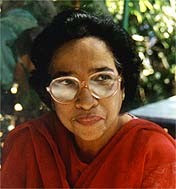

Most people who visit Cologne head for the Cologne Cathedral, which is one of the most important works of Gothic architecture in Europe. But the basilica of St. Ursula which is just a few streets away does not attract much attention. The revenues of this church go solely to the Abbess of the Ursuline Order and six other canonesses.
The story of Ursula a British princess is a sad one. She lived in the 5th century A.D. and was the daughter of King Donaut of Dummonia in south west England. Much against her wishes, she was betrothed to Governor Conan Meriodoc of Brittany. Ursula begged her father for a three-month reprieve, with the excuse that she wanted to go to Rome to be baptized.
Ursula sailed with 11 virgins for company. But a storm drove the vessel down to Cologne instead. Here this group of young women was martyred by the Huns in 453 A.D. Ursula was shot with an arrow. But the rest of the virgins were beheaded.
As time went by, a legend grew around Ursula and her band of virgins. She had an assistant called Undecimilla. Someone mistook this to be Undecim Millia meaning 11,000. And so the story spread that Ursula was accompanied by 11,000 virgins. But in 1969, Pope Paul VI called the story a figment of imagination, and removed Ursula from the canon of saints.
The Feast of Ursula is celebrated on the 21st of October. The Basilica dedicated to her is built on an ancient Roman cemetery. In the 16th century, the Romans slaughtered thousands of Christians not sparing even little children.
Attached to the Basilica is a chapel called the Golden Krammer, (Golden Chamber) which was built in the 17th century. This is a weird place of worship and guaranteed to give one goose pimples when one steps into the gloomy interior. Three walls of the chapel are lined by bones of different sizes and shapes – ribs, shoulder blades, femurs and other bones. They are artistically fixed into the walls in whorls, crosses, zigzag and even in the shape of Latin alphabets. Bones of very small children are also incorporated into this work of art. Sculptures of heads and torsos are exhibited in glass cases. Some skulls are encased in silver filigree. Others are covered with caps of gold and velvet. The skulls of the sculptures open up on top like lids, to reveal smaller skulls inside. The torsos are hollow like windows with grills, revealing skulls inside the abdomens.
Ursula’s statue shows her holding an arrow in one hand, (the weapon that killed her) and a pilgrim’s staff surmounted by a white banner with a red cross – the Christian standard of victory. A crown on her head shows that she is a princess. Many pilgrims come here believing that if they touch the bones of these martyrs, miracles would take place in their own lives. The pilgrims always carried back relics that were sold in the chapel.
There is no artificial cooling here. The temperature remains at a constant
18 degrees centigrade. Two stained glass windows on the outer wall let in some light.
There are large concrete sarcophagi both inside and outside the chapel containing millions of bones recovered from the cemetery, over which the church was built. It is said that during World War II, the chapel was protected by a slab of concrete. Though the rest of the Basilica was bombed, the chapel remained untouched.
Ursula is the patron saint of young girls because she and her virgins were young women when they were martyred. The Order of the Ursulines was established in 1535, by a woman called Angela Merci. This Order is devoted to the education of young girls.










